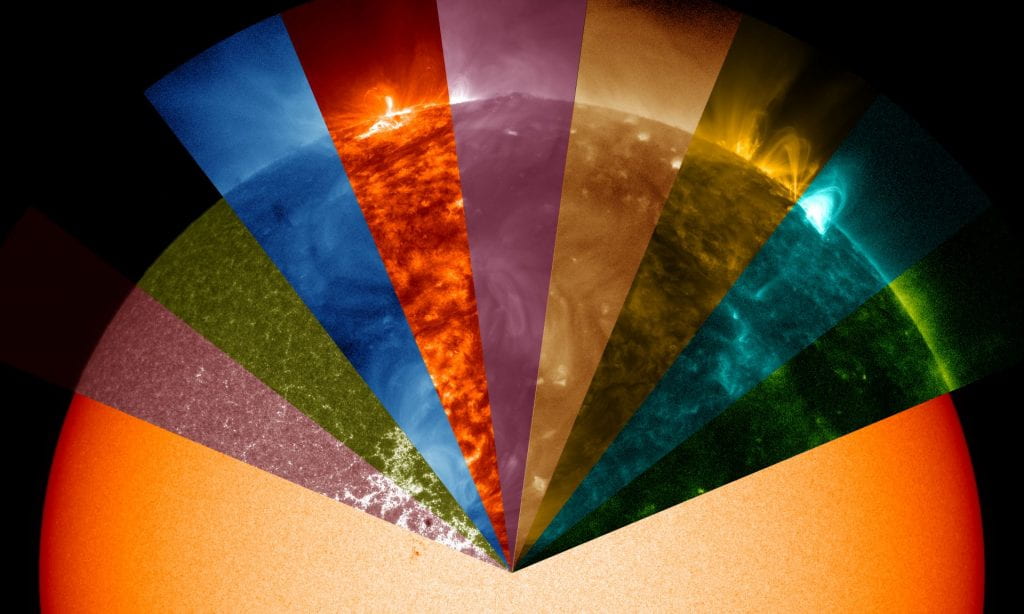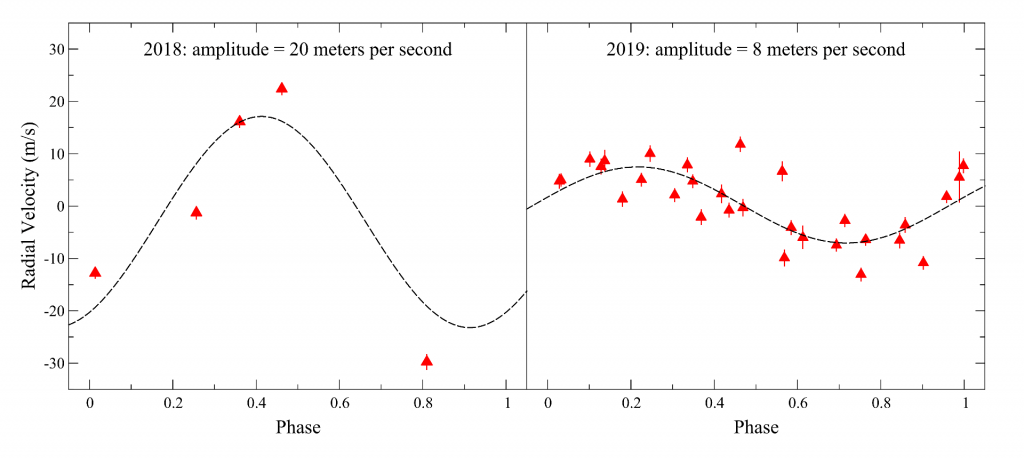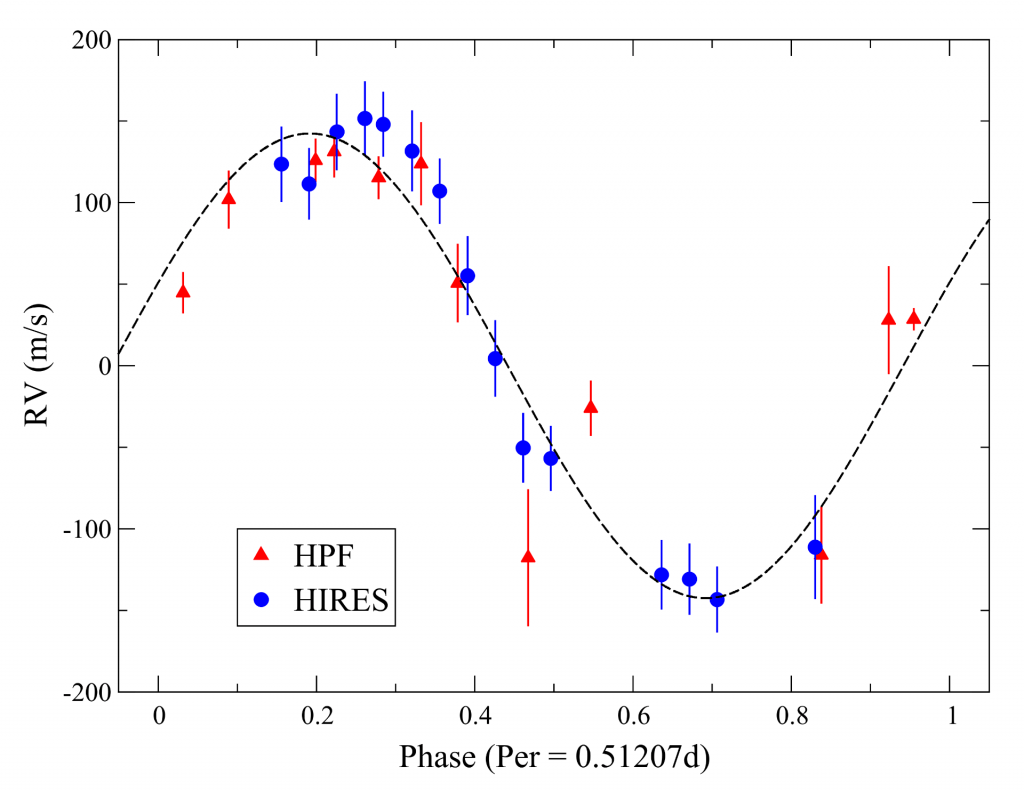Introduction
Much of our time on sky with HPF is dedicated to discovering exoplanets, and measuring their detailed properties. To do this, we concentrate our efforts on older, magnetically quiet stars to minimize noise and make the planets easier to detect. But M dwarf stars are astrophysically interesting in their own right, and we have reserved a small amount of our observing time to studying younger, more active M stars. In this post, we’ll look at a new result our team has just published, from an experiment in which we looked at some very active stars in an attempt to understand differences in Doppler signals originating from exoplanets and magnetic activity.
“An Easy Target”
Back in 2018, when we were just getting HPF on sky, a team of astronomers analyzing archival radial velocity data from the Keck/HIRES and HARPS spectrometers announced a fascinating discovery. Examining years’ worth of Doppler measurements of AD Leonis–a very young and active M dwarf star–they found a periodic signal at around 2.2 days, which matches the star’s rotation period. Ordinarily, one would dismiss a Doppler signal at the rotation period because it is almost certainly caused by magnetic starspots rotating across the stellar surface. However, the HIRES and HARPS data appeared to show a signal that was consistent for years at a time, which is not expected of starspots. Spots should disappear within a few rotations of the star, so the hypothesis presented for AD Leo was that this signal represented a giant planet whose orbit was coupled to the rotation of the star. If true, this would be a rare and exciting discovery! But the specter of starspots left this possibility stuck in “candidate planet” limbo.
This type of situation is exactly what HPF, with its near-infrared wavelength coverage, was built for. We expect starspot signals to be chromatic: that is, the size of the signal will change depending on the wavelengths (or colors) you observe them with. This is due to the fact that the color contrast between a cool starspot and the surrounding stellar atmosphere is greater at visible wavelengths than in the infrared.

Multi-wavelength images of the Sun, as captured by NASA’s Solar Dynamics Observatory (SDO). Various features of the Sun’s atmosphere appear more prominently at certain wavelengths. Image Credit: NASA Goddard Space Flight Center
On the other hand, a genuine exoplanet should show no such wavelength dependence. So if the signal for AD Leo is due to a real planet, it should look exactly the same for HPF as it did for the optical-wavelength HIRES and HARPS. The nice thing about the AD Leo signal is that it is so massive as to be easily detected by HPF, even if it didn’t hit its full measurement precision goals straight out of the gate. Given the timing of the announcement of the planet candidate, it seemed like an obvious choice for HPF’s first science project. Once HPF was set up and running, we immediately started collecting observations of AD Leo.
Too much of a good thing
In 2018, we watched AD Leo until it set for the season, and were extremely encouraged. Our data showed a signal that matched extremely well to the HIRES and HARPS data, as we would expect if the signal were caused by a planet. We were confident enough in the status of the planet that we wrote a complete draft of a research journal paper titled “Near-infrared radial velocities confirm AD Leonis b,” and were on the verge of submitting it for publication.
But then we looked at our next target, and pulled the emergency brake. Because we saw the same thing again.
G 227-22 is another young, rapidly-rotating M star. The MEarth team, who are looking for planets that transit nearby M dwarfs, showed that it completes a rotation every 6 hours, which is remarkably fast. It was another early science target for HPF, because the TESS satellite is collecting an enormous amount of data for it, which is especially valuable for studying stars and their planets. What complicated our interpretation of AD Leo is that HPF radial velocities of G 227-22 also showed a signal at the stellar rotation period that did not change or disappear, even over many stellar rotations.
To see two such similar rotation-period signals among HPF’s early set of targets could not be coincidence. We saw two possible interpretations for this result, neither of which seemed especially intuitive:
- Both AD Leo and G 227-22 have giant exoplanets in orbits coupled to those stars’ rotation. But for us to find two such objects among our first two targets would suggest that nearly all young M dwarfs must have this type of planet! This seemed inconsistent with previous studies of M stars.
- These signals are caused by magnetic starspots. However, in order for them to produce the Doppler signals we saw, they would have to behave quite differently from what we see on the Sun.
It seemed impossible to convincingly distinguish between these possibilities without more data. So our results for AD Leo were frustratingly put on hold.
A multi-color Doppler campaign

The Hobby-Eberly (left) and Keck I and II (right) telescopes.
Either of the two possibilities above are quite interesting from an astrophysics perspective, so we were determined to settle the debate. The approach we decided to take was to mount an intensive, multi-wavelength Doppler observing campaign for AD Leo, G 227-22, and two more similar stars (GJ 1245B and GJ 3959). We set out to get both visible and near-infrared radial velocity measurements, which involved enlisting two 10-meter telescopes: in addition to HET, which houses HPF, we enlisted the HIRES spectrometer on the Keck I Telescope in Hawaii. The idea was that if any (or all!) of these stars hosted spin-orbit coupled planets, their visible and infrared Doppler signals should look the same. Our experiment benefited from TESS observing these stars at around the same time, so our targets received quite a bit of attention during the 2019 observing season!
Spots that won’t quit
Once we completed our observations, it became apparent that none of our targets seem likely to host a planet orbiting at the period of the stars’ rotation. The signals appear to shift in phase, and typically have smaller amplitudes in the infrared wavelengths, as we would expect from starspots. Even the AD Leo signal finally gave way in 2019–the infrared signal was much smaller than we saw in 2018, and another team has confirmed that it was also smaller at optical wavelengths.

HPF radial velocities of AD Leo from 2018 (left) and 2019 (right). The shrinking amplitude confirms the signal is caused by stellar magnetic activity, not a planet.
Still, it’s interesting to look in more detail at what caused us and other teams to suspect planets in the first place. These spots do not act like what we observe on the Sun! What we found is that the signals from these spots stay constant for 6 months to a year, typically. But since these stars complete a rotation every few days or less, that means these signals persist for hundreds–or even thousands–of stellar rotations. For comparison, Sunspots typically disappear within one or two rotations. Below, we show the brightness of G 227-22, as measured by TESS. The consistency of the brightness variations suggests the spot patterns on the star stay fixed over time.

Brightness measurements of G 227-22, as measured by TESS. Moving from bottom to top, we see how the star dims as regions with more starspots rotate into view. From left to right, we see that the brightness distribution does not change over time, suggesting the spot pattern is fixed over many stellar rotations.
This adds to the challenge of finding exoplanets with the Doppler technique, because if we can’t rely on starspot signals to degrade over short periods of time, then we need more information to help separate real planets from false positives. Once again, we learn that there’s no such thing as an “easy target,” especially when dealing with M dwarfs.
Really, no planets?
Probably not! But we’ll leave you with a little cliffhanger, just for fun. Remember in the previous section where we said that the observed starspot signals “typically” had smaller amplitudes in the infrared? Well, there was one target–GJ 3959– for which the optical and infrared signals match up surprisingly well. Take a look:

Optical Keck/HIRES (blue) and near-infrared HPF (red) radial velocities of GJ 3959, shown at the phase of the star’s rotation. The optical and infrared signals match in phase and amplitude.
We were almost tempted to label this signal a planet candidate. However, our colleagues on the CARMENES team have also looked at this star, and observed evidence of wavelength-dependent Doppler shifts. Thus, we concluded that this signal is most likely caused by starspots, and the spots may have changed size between the times we observed with HIRES and HPF, leading to the signals coincidentally matching. However, there’s one more chance to determine whether this might be the real deal: TESS is observing this star as we write, and the first data are scheduled to come down any day now. If there is a planet here, it has a high probability of transiting, and thus being detected by TESS! If that happens, you’ll see us frantically updating this post.
Where can I learn more?
A research article describing this experiment in full detail has been accepted for publication in the Astrophysical Journal. Prior to publication, you can read the pre-print on arXiv.

 RSS - Posts
RSS - Posts